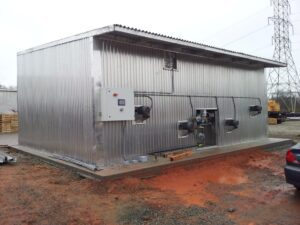Table of Contents
Is kiln-dried lumber really better than air-dried variant?
Before using lumber for commercial purposes, it undergoes a drying process to remove much of its moisture. Conventionally, lumber was air-dried to bring the moisture content to optimal levels. However, it is not the ideal way and this process has multiple drawbacks. Nowadays, kiln-drying is the preferred way of drying lumber and preparing it for commercial uses.
An industrial-grade lumber kiln is a large-scale furnace that is used for drying clay and wood. In a kiln, temperature, airflow, and humidity levels can be controlled which gives the user better control over the end product. Let us take a look at the multiple advantages of kiln-drying over air-drying.
It Has Uniform Quality
- In a kiln, there is a consistent and continuous supply of heat and warm air. Due to the uniform distribution of heat, dried lumber has a more consistent and uniform quality and appearance. In air drying, all areas of the lumber are not equally treated. Lumber that lacks consistency in quality wears off easily. Some parts of the lumber will deteriorate faster than others which will affect the appearance of the entire project.
It is Easier to Install
- In industrial kilns, lumber is dried under controlled conditions of temperature, pressure, and humidity. All these parameters are set in such a way that dried wood will retain 17-19% of moisture content, depending upon usage. Kiln-dried wood does not shrink further and retains its optimal moisture content. As a result, kiln-dried wood has more practical uses and is easier to install. After installation, it neither shrinks nor warps rather maintains a consistent size. Kiln-drying speeds up the project as the wood is ready to be installed right after it comes out of the kiln.
It is Long-Lasting and More Durable
 Air-dried wood retains moisture and it shrinks and warps when installed in high-temperature areas. This affects the quality and life of the floors, ceiling tiles, and other areas where the lumber is used. Kiln-dried wood does not lose its structural integrity and is suitable for multiple climates and weather conditions. Kiln-dried wood holds its shape in extreme temperatures and does not deteriorate easily.
Air-dried wood retains moisture and it shrinks and warps when installed in high-temperature areas. This affects the quality and life of the floors, ceiling tiles, and other areas where the lumber is used. Kiln-dried wood does not lose its structural integrity and is suitable for multiple climates and weather conditions. Kiln-dried wood holds its shape in extreme temperatures and does not deteriorate easily.
Bugs and Their Eggs Don’t Breed on Kiln-Dried Wood
- Wood is an organic material. It is hygroscopic in nature i.e. it absorbs moisture from its surroundings. These elements provide the ideal conditions for wood-eating bugs to infest the lumber. Reclaimed wood that has been air-dried often breeds colonies of bugs, causing quite a nuisance. However, when the lumber is subjected to high temperature inside the kiln, it kills off any budding infestation and removes the water, making the lumber prone to bug infestations.
It Saves Money and Is Cost-Effective
- Kiln-drying is a fast process of preparing wood for commercial uses. Air-drying takes weeks while kiln-drying can shorten this period to one day. Hence, kiln-drying is a less labor-intensive process as results are achieved in a much shorter time. Kiln-drying is an automated process that does not require the constant attention of the labor. Kiln-dried lumber is of superior quality as well and can be stored for extended periods of time without fear of bug infestation and loss of structural integrity.
With a faster drying process, larger projects can be taken on as there are no delays in the supply of wood. All in all, kiln-drying saves money and is a cost-effective process.
- Bol Design Inc presents to you state-of-the-art Package Load, Front Load, Hardwood Lumber Kiln. Designed with corrosion-resistant aluminum and highly-durable materials, these wood kilns are built to last for extended periods of time even during frequent use. With a front-load design, it’s easy to load and unload lumber, decreasing operational time and costs.
To get more information about our lumber kilns and other equipment, call us at 828-754-7001. Our office is located in Hudson, NC.

